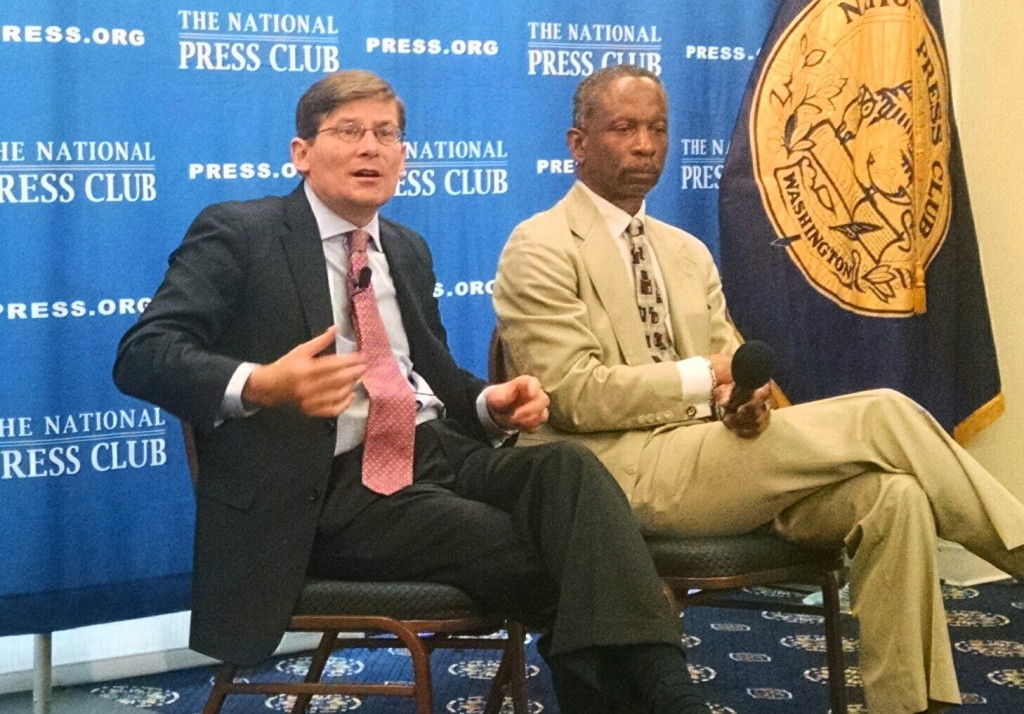
Michael Morell (on left) says al Qaida is a greater threat than ISIS. (Tanni Deb/MEDILL NSJI)
WASHINGTON — The Islamic State group has attracted foreign recruits for its war in Iraq and Syria because the extremist network has what it sees as a compelling story to share with them, according to the CIA’s former deputy director.
“Their narrative is that the West, the United States, the modern world is a significant threat to their religion [and] that they have an answer to that threat to their religion, which is the establishment of this caliphate,” said Michael Morell, who held the post from 2010 to 2013. They say “they are being attacked by the United States … and because they are being attacked as they try to set up this caliphate to protect their religion, they need support.”
Morell is the author of “The Great War of Our Time: The CIA’s Fight Against Terrorism, From al Qa’ida to ISIS,” published this month. Indeed, ISIS presents a clear threat, he said Monday at the National Press Club in Washington. But it’s al Qaida, which perpetrated the 9/11 attacks and continues to have widespread influence abroad, that remains a greater danger, he added.
“The most significant threat to the homeland today,” Morell said, “still comes from al Qaida.”
ISIS seeks support in two ways, he said. It wants fighters to carry out its war in the Middle East, and it urges people to attack Americans and other coalition nations in their homelands.
The U.S., on the other hand, doesn’t really have a strong counter narrative, he said.
“Not because we’re not doing our job, but because it’s really hard to have a counter narrative in a conversation about a religion where we have absolutely no credibility,” he said.
Morell was an intelligence analyst who delivered daily briefings to then-President George W. Bush in 2001. He also assisted with planning the 2011 raid in Pakistan that resulted in the death of Osama bin Laden. His new book includes his assessment of the CIA’s counterterrorism successes and failures of the past two decades, and highlights growing threats from terrorist groups that could impact the U.S.
Three al Qaida groups in particular pose the greatest threat to the U.S., he said.
Al Qaida in the Arabian Peninsula, based in Yemen, remains the most dangerous, Morell said. The international terrorist organization was responsible for the last three attempted attacks against the U.S.: the would-be Christmas Day underwear bomber in 2009, the printer cartridge plot in 2010 and the nonmetallic bomb plot on an airliner in 2012.
“They have the capability to bring down an airline in the United States of America tomorrow,” Morell said.
The second most dangerous, he said, is the Khorasan Group, which has operatives from Pakistan. It was formed to assist the jihadist organization Jabhat al-Nusra in its fight against the government of Syrian President Bashar al-Assad with the goal of using Syria as a base of operations to attack the West.
Finally, the third group is al Qaida’s senior leadership in Afghanistan and Pakistan, he said.
But Morell did not downplay the ISIS threat — either on the battlefield or in its attempts to radicalize young men and young women around the world.
“The first and probably the most important right now is the stability of the entire Middle East. ISIS threatens the territorial integrity of Syria, the territorial integrity of Iraq and the potential for spillover to the rest of the region,” Morell said.
ISIS killed hundreds of Iraqi civilians and security forces and caused thousands to flee their homes as it captured the city of Ramadi in central Iraq on Sunday, according to multiple news reports.
Morell said that Islamic educators are needed to inform people who may consider joining terrorist groups.
“We really need the leaders of Muslim countries, we need leading Muslim clerics [and] we need Muslim teachers to have this dialogue in those countries themselves.”






